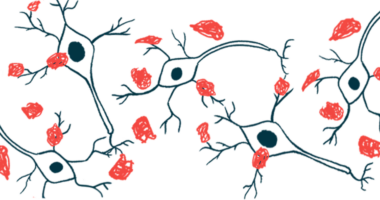Alpha-synuclein clumps may lead to calcium imbalance in Parkinson’s
Too much calcium may be tipping point in disease progression: Preclinical study

Toxic clumping of the alpha-synuclein protein, a hallmark of Parkinson’s disease, may lead to a calcium imbalance in which the mineral builds up to harmful levels in neurons early in the course of the neurodegenerative condition, according to a study in mouse and human cells.
Single molecules of alpha-synuclein were found to activate a calcium pump in the cell membrane. A calcium pump is a protein that moves calcium ions out of cells to keep calcium levels in a healthy range.
However, when alpha-synuclein started to clump, that activation shifted to another calcium pump that sits inside cells, disrupting calcium balance. This shift is believed to happen early in Parkinson’s course — and it may act as a tipping point for the disease’s development and progression, according to researchers.
This finding is an important step toward understanding the mechanisms behind Parkinson’s, the scientists noted, adding that addressing calcium balance could offer new ways of diagnosing and treating the disease.
The study, “Monomeric α-synuclein activates the plasma membrane calcium pump,” was published in The EMBO Journal.
Calcium pump in cells, when activated, prevents imbalance
In Parkinson’s, single units of alpha-synuclein can take on the wrong shape and clump together into toxic clusters that damage neurons, contributing to how the disease develops and progresses over time. The function of these free single units, however, has been unclear.
Using alpha-synuclein as a bait to catch and pull along any interacting proteins, an international team led by researchers at Aarhus University’s Danish Research Institute of Translational Neuroscience (DANDRITE), in Denmark, now found that free alpha-synuclein activates a calcium pump, called PCMA, in the cell membrane, preventing calcium from building up.
Calcium ions can move in and out of neurons, and their flow can control the amount of molecular messages sent by the neurons to neighboring cells. In neurons obtained from the mouse brain, free alpha-synuclein mapped onto PMCA at the synapse, the place of near contact between nerve cells where they release signals to communicate with each other.
Further experiments showed that free alpha-synuclein activated PMCA, as seen by a significant increase in calcium flow out of neurons.
“The activation appears to be of particular importance in the presynaptic area of neurons, which is responsible for transmitting signals in the brain’s neural network,” Poul Nissen, PhD, the study’s senior author at Aarhus University, said in a university press release.
“It is known that aSN [alpha-synuclein] accumulates in the presynaptic compartment, and our study shows, for the first time, that aSN and PMCA appear together in this area. In addition, we show that aSN stimulates calcium excretion from neurons,” Nissen added.
This novel function of [alpha-synuclein] is relevant to calcium homeostasis [balance] of neurons.
Unlike calmodulin — so far the only known activator of PMCA — single molecules of alpha-synuclein activated the calcium pump in the presence of negatively charged fatty molecules, or those with a negative electric charge. This suggests that alpha-synuclein may complement calmodulin, which acts in neutral or positively charged environments.
“This novel function of aSN is relevant to calcium homeostasis [balance] of neurons and specifically presynaptic compartments, where PMCA plays a key role in calcium homeostasis,” the researchers wrote.
While early, findings open door to possible diagnostic, treatment strategies
Abnormal calcium flow has been linked to early formation of alpha-synuclein toxic clumps in neurons from Parkinson’s patients carrying mutations in the SNCA gene. That gene provides instructions to make alpha-synuclein.
“Our laboratory has previously shown that early clump stages of aSN activate another calcium pump, SERCA, which sits in an internal organelle [structure] of the cell” called the endoplasmic reticulum, said Poul Henning Jensen, MD, PhD, another study researcher from Aarhus.
Building upon this information, the researchers further observed that while SERCA was indeed activated by small alpha-synuclein clumps, or aggregates, it was not activated as much by the protein’s single units. The reverse was true for PMCA.
Moreover, an alpha-synuclein protein resulting from A30P — a SNCA mutation linked to Parkinson’s that causes the protein to clump at a much faster rate — did not activate PMCA as much as the normal protein in the presence of negatively charged fatty molecules.
This suggests that when alpha-synuclein starts to clump, the activation shifts from PMCA to SERCA, which pumps calcium ions back into the endoplasmic reticulum, increasing calcium levels within neurons.
A mathematical model revealed that PMCA activation is likely to be key for calcium balance, when neurons signal repeatedly, and calcium ions flow in constantly. Free alpha-synuclein would prevent a buildup of calcium that could be toxic to neurons.
It is possible that early manifestations of Parkinson’s may arise from a disruption of calcium balance due to alpha-synuclein clumping or to mutations, like A30P, that change the protein’s ability to bind to fatty molecules.
While future studies are needed to further explore the link between alpha-synuclein and calcium balance, these findings open the door to potential diagnostic and treatment strategies aimed at addressing early calcium changes in Parkinson’s and other neurodegenerative diseases, according to researchers.








